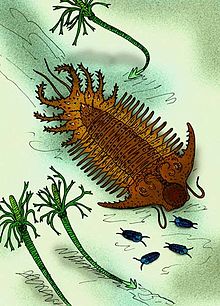Terataspis
| Terataspis grandis Temporal range:
| |
|---|---|

| |
| Scientific classification | |
| Kingdom: | |
| Phylum: | |
| Class: | |
| Order: | |
| Family: | |
| Genus: | Terataspis
|
| Species: | T. grandis
|
Terataspis is a comparatively huge, 60 centimetre long lichid trilobite genus from the Early Devonian, about 397 million years ago. It lived in a shallow sea in what is now New York State and Ontario. No whole specimens have been found, only disarticulated fragments of its exoskeleton, but enough fragments have been found to allow researchers to form reconstructions of the whole animal. The genus only contains one species, T. grandis.
T. grandis, like many other trilobites, was presumed to have been a detritivore that was also an opportunistic predator, preying on small burrowing animals, such as molluscs, worms, or arthropods.[1]

Description
Almost the entire body of T.grandis is covered with spines and tubercles of varying sizes. The pygidium is large and shield-like with four pairs of slightly curved barbed spines on the sides. The thorax consists of around 11 segments. The cephalon is characterized by its swollen front portion and longitudinal furrows that delinates a pair of swellings that located in line with the eyes. The hypostome is almost flat and kidney-shaped and has a poorly defined central body.[2]
References
- ^ "Largest Trilobites". Sam M. Gon III. 2005-08-17. Retrieved 2020-04-28.
- ^ Fossils of Ontario: Part 1: The Trilobites. Rolf Ludvigsen. 1979
